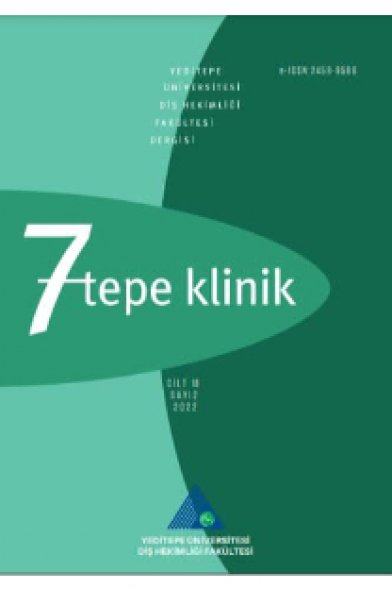Pedodonti kliniği hastalarının ağız boşluğunda Staphylococcus aureus ve metisiline dirençli Staphylococcus aureus (MRSA) varlığı
Presence of Staphylococcus aureus and methicillin-resistant Staphylococcus aureus (MRSA) in the oral cavity of pedodontics clinics patients
___
- 1. Barrett FF, McGehee RF, Jr., Finland M. Methicillin-resistant Staphylococcus aureus at Boston City Hospital. Bacteriologic and epidemiologic observations. N Engl J Med 1968; 279: 441-448.
- 2. Weber JT. Community-associated methicillin-resistant Staphylococcus aureus. Clin Infect Dis 2005; 41 Suppl 4: S269-272.
- 3. Koukos G, et. al. Prevalence of Staphylococcus aureus and methicillin resistant Staphylococcus aureus (MRSA) in the oral cavity. Arch Oral Biol 2015; 60: 1410-1415.
- 4. McCormack MG, et. al. Staphylococcus aureus and the oral cavity: an overlooked source of carriage and infection? Am J Infect Control 2015; 43: 35-37.
- 5. Petti S, et. al. Low methicillin-resistant Staphylococcus aureus carriage rate among Italian dental students. Am J Infect Control 2015; 43: e89-91.
- 6. Apolonio-Alonso AN, Acosta-Gio AE, Bustos-Martinez J, Sanchez-Perez L, Hamdan-Partida A. Methicillin-resistant Staphylococcus aureus among dental patients. Am J Infect Control 2011; 39: 254-255.
- 7. Kurita H, Kurashina K, Honda T. Nosocomial transmission of methicillin-resistant Staphylococcus aureus via the surfaces of the dental operatory. Br Dent J 2006; 201: 297-300.
- 8. Roberts MC, Soge OO, Horst JA, Ly KA, Milgrom P. Methicillin-resistant Staphylococcus aureus from dental school clinic surfaces and students. Am J Infect Control 2011; 39: 628-632.
- 9. Diekema DJ, et. al. Survey of infections due to Staphylococcus species: frequency of occurrence and antimicrobial susceptibility of isolates collected in the United States, Canada, Latin America, Europe, and the Western Pacific region for the SENTRY Antimicrobial Surveillance Program, 1997-1999. Clin Infect Dis 2001; 32 Suppl 2: S114-132.
- 10. CLSI. Performance Standards for Antimicrobial Susceptibility Testing. 27th ed. CLSI supplement M100. Wayne, PA: Clinical and Laboratory Standards Institute; 2017.
- 11. Marchese A, Gualco L, Maioli E, Debbia E. Molecular analysis and susceptibility patterns of meticillin-resistant Staphylococcus aureus (MRSA) strains circulating in the community in the Ligurian area, a northern region of Italy: emergence of USA300 and EMRSA-15 clones. Int J Antimicrob Agents 2009; 34: 424-428.
- 12. Stegger M, et. al. Rapid detection, differentiation and typing of methicillin-resistant Staphylococcus aureus harbouring either mecA or the new mecA homologue mecA(LGA251). Clin Microbiol Infect 2012;18:395-400.
- 13. Marsh PD, Martin MV. Oral Microbiology. 5th ed. Churchill Livingstone: Elsevier Health Sciences; 2009.
- 14. McCarthy C, Snyder ML, Parker RB. The indigenous oral flora of man. I. The newborn to the 1-year-old infant. Arch Oral Biol 1965; 10: 61-70.
- 15. Jackson MS. Staphylococci in the oral flora of healthy children and those receiving treatment for malignant disease. Microb Ecol Health Dis 2000; 12: 60-64.
- 16. Millar MR, et. al. Carriage of antibiotic-resistant bacteria by healthy children. J Antimicrob Chemother 2001; 47: 605-610.
- 17. Miyake Y, et. al. Incidence and characterization of Staphylococcus aureus from the tongues of children. J Dent Res 1991; 70: 1045-1047.
- 18. Suzuki J, Yoshimura G, Kadomoto N, Kuramoto M, Kozai K. Long-term periodical isolation of Staphylococcus aureus and methicillin-resistant Staphylococcus aureus (MRSA) from Japanese children’s oral cavities. Pediatric Dental Journal 2007; 17: 127-130.
- 19. CAESAR. Annual report 2017. Copenhagen: WHO Regional Office for Europe; 2017.(http://www.euro.who.int/ data/assets/pdf_file/0005/354434/WHO_CAESAR_AnnualReport_2017.pdf?ua=1, accessed 12 July 2017).
- 20. European Centre for Disease Prevention and Control. Antimicrobial resistance (EARS-Net). In: ECDC Annual epidemiological report for 2014. Stockholm: ECDC; 2018.
- 21. Duman Y, Tekeroglu MS, Otlu B. Toplum ve hastane kökenli Staphylococcus aureus klinik izolatlarinda Panton-Valentine lökosidin varlığının ve klonal ilişkinin araştırılması. Mikrobiyol Bul 2013; 47: 389-400.
- 22. Sancak B. Staphylococcus aureus ve antibiyotik direnci. Mikrobiyol Bul 2011; 45: 565-576.
- 23. Hiramatsu K, et. al. Methicillin-resistant Staphylococcus aureus clinical strain with reduced vancomycin susceptibility. J Antimicrob Chemother 1997; 40: 135-136.
- 24. Jones RN, et. al. Resistance surveillance program report for selected European nations (2011). Diagn Microbiol Infect Dis 2014; 78: 429-436.
- 25. Oksuz L, Gurler N. Susceptibility of clinical methicillin-resistant Staphylococci isolates to new antibiotics. J Infect Dev Ctries 2013; 7: 825-31.
- 26. Stryjewski ME, Corey GR. New treatments for methicillin-resistant Staphylococcus aureus. Curr Opin Crit Care 2009; 15: 403-412.
- 27. Tekin A, et. al. In vitro susceptibility to methicillin, vancomycin and linezolid of staphylococci isolated from bloodstream infections in eastern Turkey. Braz J Microbiol 2014; 45: 829-833.
- 28. Zhanel GG, et. al. Prevalence of antimicrobial-resistant pathogens in Canadian hospitals: results of the Canadian Ward Surveillance Study (CANWARD 2008). Antimicrob Agents Chemother 2010; 54: 4684-4693.
- ISSN: 2458-9586
- Yayın Aralığı: 3
- Başlangıç: 2005
- Yayıncı: Yeditepe Üniversitesi Rektörlüğü
Güler Burcu SENİRKENTLİ, Resmiye Ebru TİRALİ
DİLEK TÜRKAYDIN, FATIMA BETÜL BAŞTÜRK, Seda ÖZYÖNEY, Yıldız GARİP BERKER, Hesna Sazak ÖVEÇOĞLU, Mahir GÜNDAY
Erişkin Hastada Ön Açık KapanışınZygomatik Ankraj ile Tedavisi: Bir olgu sunumu
Defne ÇALDEMİR YANIK, Sönmez FIRATLI, Pınar ÜNLÜ KUTAY
İSMAİL GÜMÜŞSOY, Şuayip B. DUMAN, İbrahim S. BAYRAKDAR, YASİN YAŞA, Binali ÇAKUR
Sebaceous glands within odontogenic cysts
Anterior Open Bite Treatment with Zygomatic Anchorage in Adult Patient: A case report
Defne ÇALDEMİR YANIK, Pınar ÜNLÜ KUTAY, SÖNMEZ FIRATLI
Evaluation of maxillofacial fracture cases: A retrospective study
HATİCE HOŞGÖR, FATİH MEHMET COŞKUNSES, BAHADIR KAN
MUAMMER ÇAĞRI BURDURLU, FATİH CABBAR, VOLKAN ÇAĞRI DAĞAŞAN, Sezer IŞIKSAÇAN
Maksillofasiyal kırık olgularının değerlendirilmesi: Retrospektif bir çalışma
